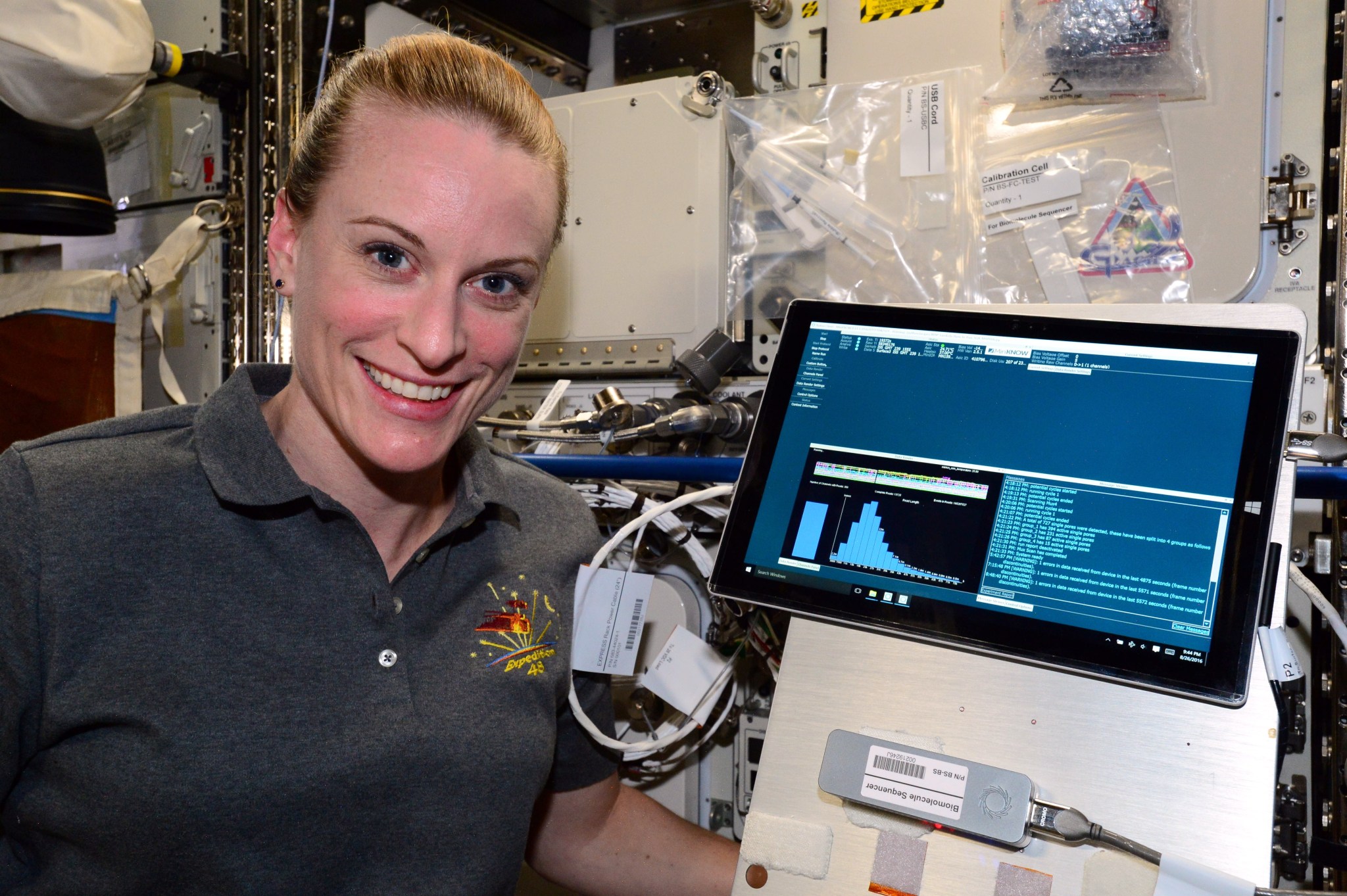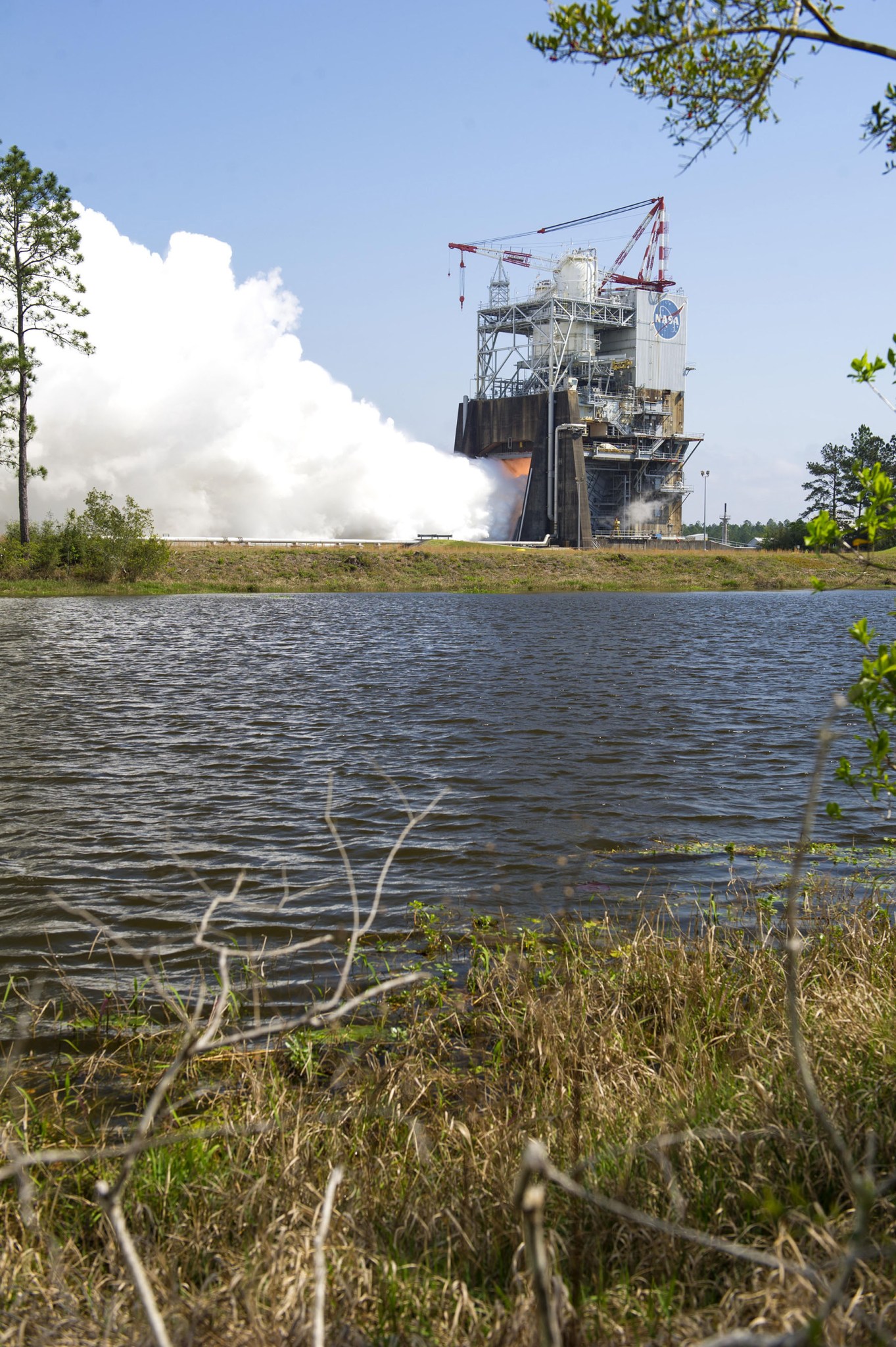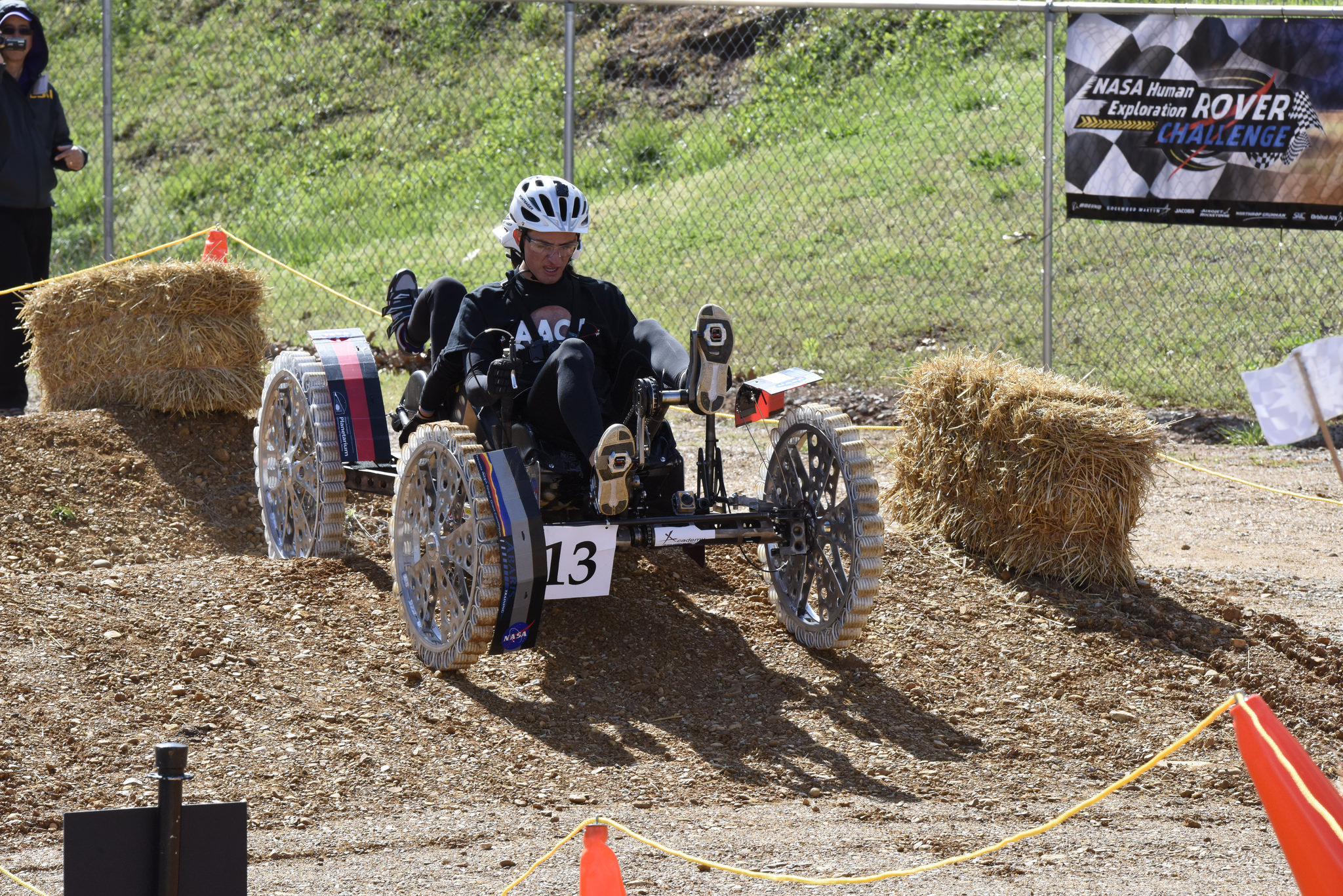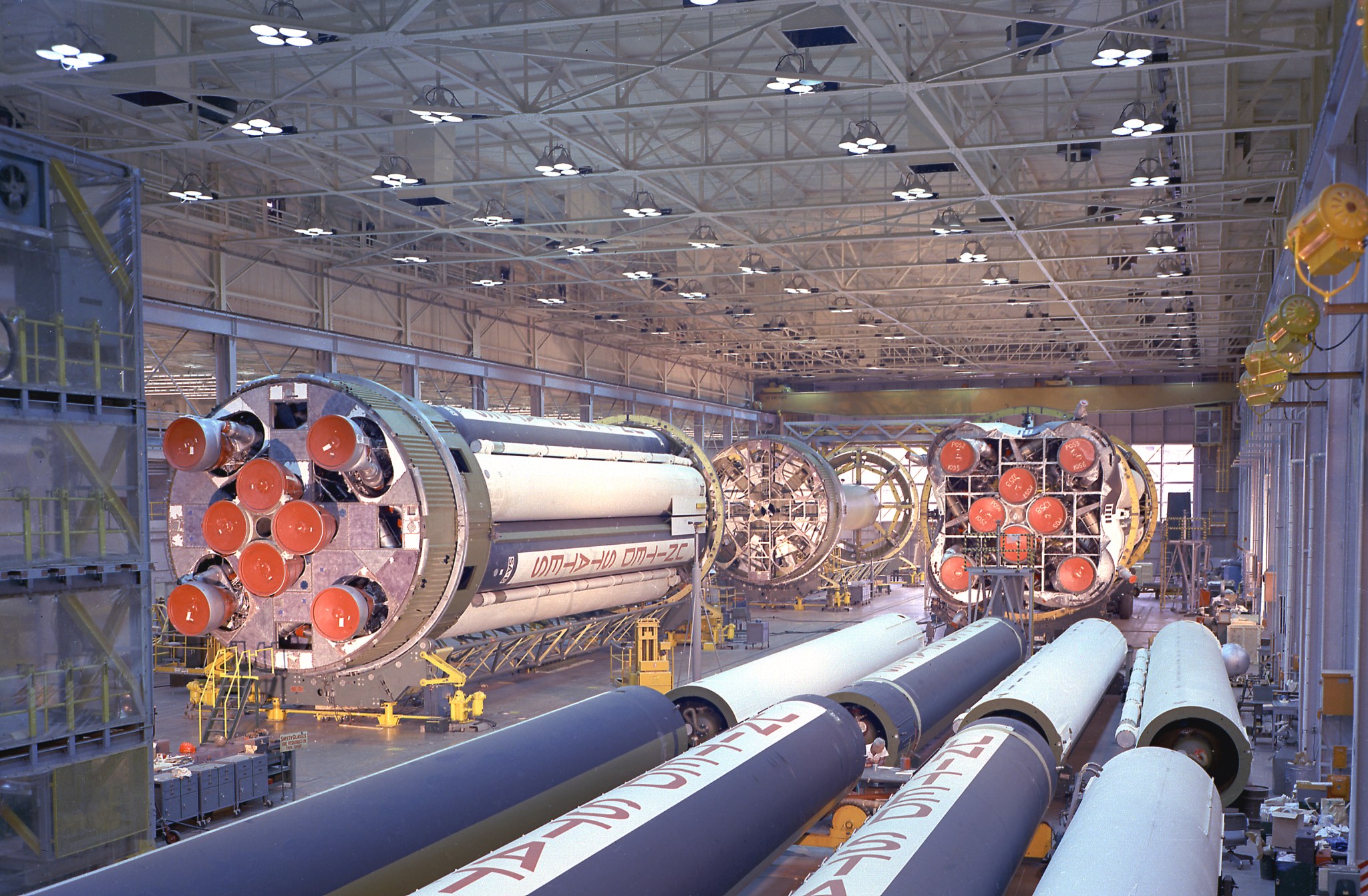In This Week’s Star
- NASA Astronaut Kate Rubins to Visit Marshall on April 6
- First Piece of SLS Integrated Hardware Arrives at Cape
- Space Station Crew Conducts Spacewalk to Prepare for New Visitors
- New Flight Controller Tested on RS-25 Engine
- NASA’s International Space Apps Challenge Comes to Huntsville April 29-30
- Watch Nearly 100 Teams Race at March 31-April 1 Rover Challenge
- Marshall-sponsored Team Rolls Robot to a Win in Rocket City Regional
- Thomas Zurbuchen, NASA Associate Administrator for Science, Speaks at Marshall
- This Week in NASA History: Saturn I SA-4 Test Flight Launches — March 28, 1963
- Obituary
NASA Astronaut Kate Rubins to Visit Marshall on April 6
NASA astronaut Kate Rubins, who lived and worked on the International Space Station as a flight engineer from July to October 2016, will visit NASA’s Marshall Space Flight Center April 6. She will share highlights from her mission to space as part of the Expedition 48 and 49 crews.
During her four-month stay on the station, Rubins became the first person to sequence DNA in space,researched technology development, Earth and space science. She also grew heart cells in cell cultures while conducting experiments in molecular and cellular biology, human physiology, fluids and combustion physics.
Rubins and NASA astronaut Jeff Williams conducted two spacewalks outside the station. The first spacewalk helped prepare the orbiting laboratory for the future arrival of U.S. commercial crew spacecraft when the crew members installed an International Docking Adapter. During the second spacewalk, they performed maintenance of the station external thermal control system and installed high-definition cameras, enabling never-before seen images of Earth and station.
Rubins will present mission highlights, take questions and sign autographs for the Marshall workforce at 1 in Morris Auditorium, Building 4200.
For more information about Rubins, click here.
First Piece of SLS Integrated Hardware Arrives at Cape
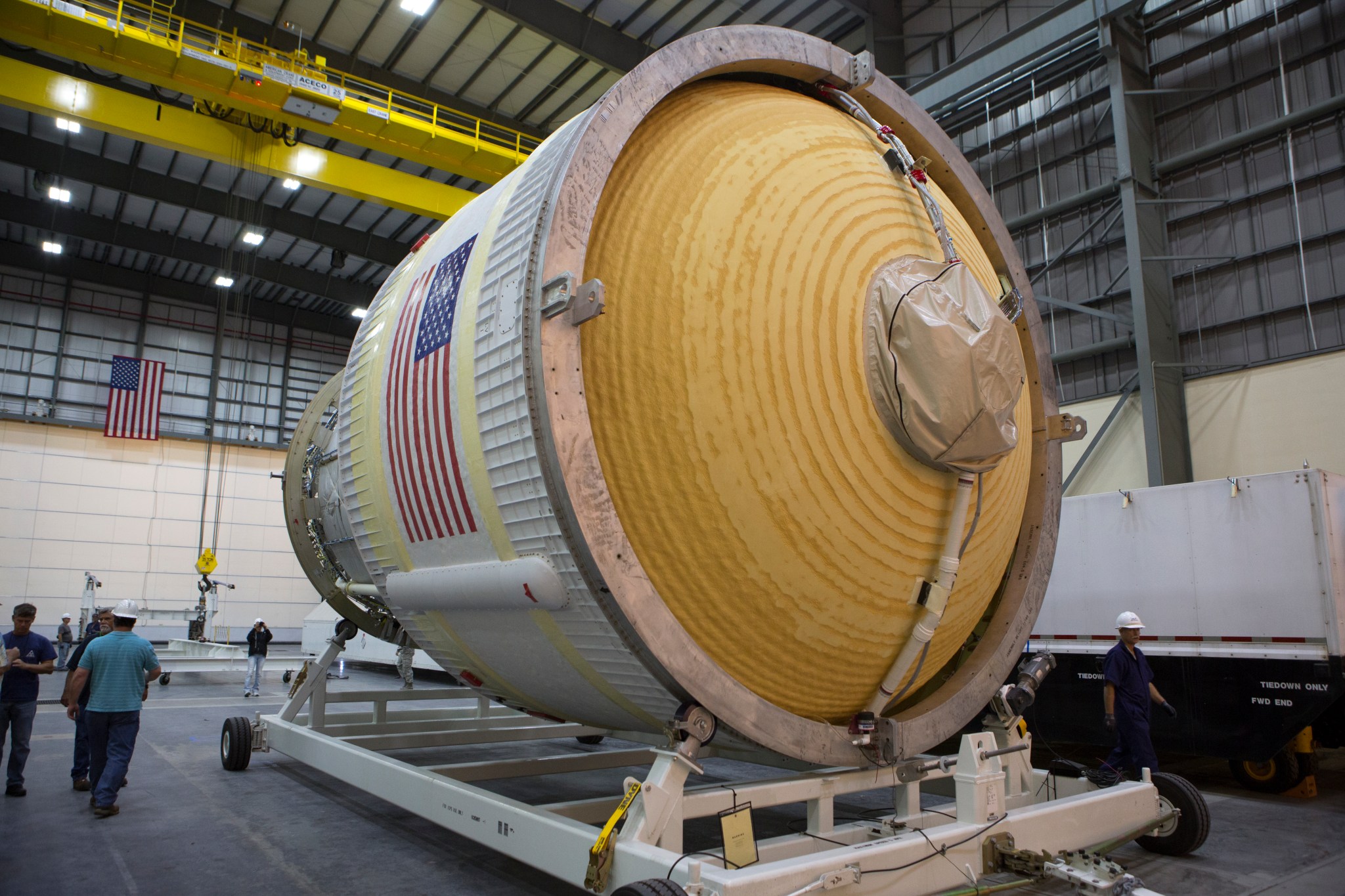
The Interim Cryogenic Propulsion Stage for NASA’s Space Launch System, the first integrated piece of flight hardware to arrive for testing at United Launch Alliance’s facility, is secured on a movable transport stand at Cape Canaveral Air Force Station in Florida. The ICPS is the in-space stage that is located toward the top of the rocket, between the Launch Vehicle Stage Adapter and the Orion Spacecraft Adapter. During the spacecraft’s first flight atop the powerful SLS rocket, Exploration Mission-1, it will provide some of Orion’s in-space propulsion. For more photos, click here. (NASA/Ben Smegelsky)
Space Station Crew Conducts Spacewalk to Prepare for New Visitors
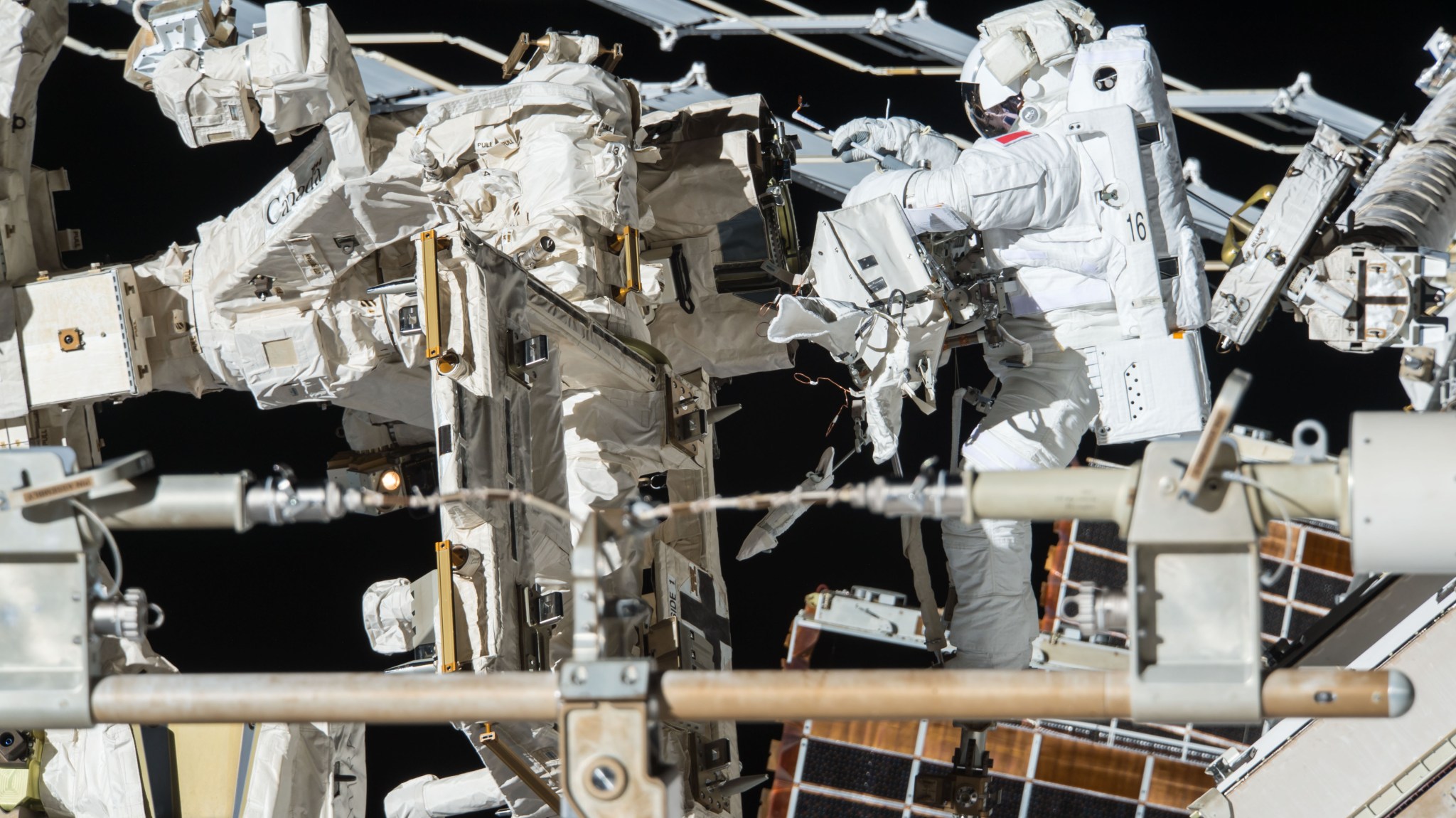
European Space Agency astronaut Thomas Pesquet works on the Canadarm2 during a spacewalk outside the International Space Station on March 24. Canadarm2 is a remote-controlled arm used to transfer cargo and release satellites on the space station. During the six-and-a-half-hour spacewalk, Pesquet and NASA astronaut Shane Kimbrough also prepared the Pressurized Mating Adapter-3 for eventual transfer to another part of the station by Canadarm2. The adapter provides the interface between station modules and the docking adapter, which will accommodate future commercial crew vehicle dockings. Two more spacewalks are scheduled for the next two weeks. (NASA)
New Flight Controller Tested on RS-25 Engine
NASA engineers conducted a test on March 23 of the new RS-25 engine controller that will be used on the first flight of the Space Launch System. The engine controller was installed on RS-25 development engine no. 0528 for the test at NASA’s Stennis Space Center. The RS-25 engine, with the flight controller, was test fired for a full-duration 500 seconds. This is a modern version of the RS-25 controller that helped propel all space shuttle missions into orbit. The controller manages the engine by regulating the thrust and fuel mixture ratio and monitors the engine’s health and status — much like the computer in your car. The RS-25 and controller work are a collaborative effort between NASA and prime contractor Aerojet Rocketdyne of Sacramento, California, and subcontractor Honeywell of Clearwater, Florida. Video of the full test is available here. (NASA/Stennis)
NASA’s International Space Apps Challenge Comes to Huntsville April 29-30
NASA’s International Space Apps Challenge is an international hackathon that occurs over 48 hours in cities around the world, engaging thousands of global citizens to work with NASA in designing innovative solutions to global challenges using open source data. For the first time, Huntsville will host regional participants for 32 hours on April 29-30.
The local event, to be held at Huntsville STEAM Works at Lowe Mill, is being sponsored by the Greater Huntsville Section of the American Institute of Aeronautics and Astronautics and New Leaf Digital. This year, the theme of the International Space Apps challenge will be Earth observation applications. Additional challenges offered at the Huntsville regional hackathon will involve virtual reality, augmented reality, electronic circuit prototyping and 3-D printing for applications related to space transportation and living and working in space.
The Huntsville Space Apps Challenge events are free, open to the public and will feature several keynote speakers. NASA Marshall Chief Technologist Andrew Keys will kick off the events on April 29 at 9 a.m. Other speakers to be featured over the two-day event include NASA Marshall Space Flight Center’s Monsi Roman, project manager for NASA’s Centennial Challenges Program. The event will conclude April 30, when teams will present their solutions to challenges.
NASA civil servants are not eligible to compete in the SpaceApps competition, and NASA contractors who wish to compete should do so during their personal time. All NASA team members may volunteer at the event, serve as a judge or help to develop design challenges specifically for the Huntsville competition.
Organizers of the event are looking for general problem statements capturing an engineering challenge that teams can work on over the course of the hackathon. Since the Huntsville competition will take place in a space equipped with manufacturing and prototyping equipment, the challenges can be hardware-focused. Anything created during the course of the competition, hardware or software, is considered non-proprietary and open source.
The deadline for submission of challenges is April 10. Challenge ideas, inquiries about judging or volunteering, and questions about civil servant and contractor participation should be submitted to David Reynolds at david.reynolds@nasa.gov.
Watch Nearly 100 Teams Race at March 31-April 1 Rover Challenge
By Megan Davidson
Come see nearly 100 high school and college teams race rovers of their own design March 31-April 1 at the U.S. Space & Rocket Center in Huntsville.
At the 2017 NASA Human Exploration Rover Challenge, student teams are required to design, build, test and race human-powered rovers, driven by one male and one female team member. The nearly three-quarter-mile course has 17 obstacles that simulate terrain found on Mars, other planets, moons and asteroids throughout the solar system. Teams race to finish the course with the fastest times to win prizes in several competitive divisions.
Teams will compete from 7:30 a.m. to 5 p.m. March 31 and April 1. The event concludes with a ceremony at approximately 5 p.m. April 1 in the U.S. Space & Rocket Center’s Davidson Center for Space Exploration. Sponsors will present awards for best design, rookie team, pit crew award and other accomplishments.
The two-day event and awards ceremony will be streamed live online on Marshall’s Ustream site. Both days of the race also will be available live on the NASA Rover Challenge Facebook page. Updates will be posted throughout the event on Twitter.
Davidson, an ASRC Federal/Analytical Services employee, supports the Office of Strategic Analysis & Communications.
Marshall-sponsored Team Rolls Robot to a Win in Rocket City Regional
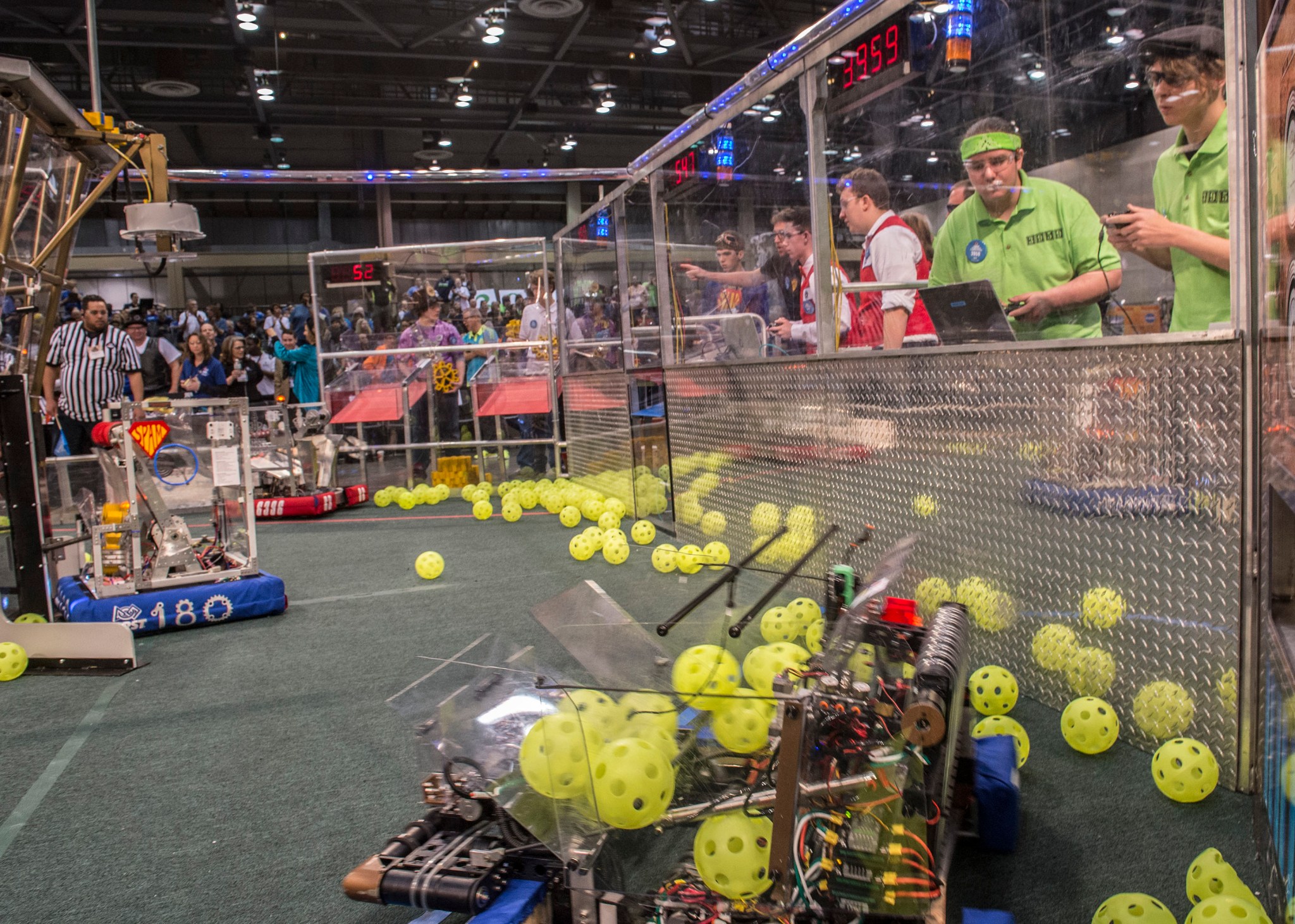
Morgan County Mech Tech team members, at right in green, are intent on the action as they maneuver their robot to pick up and toss balls of “fuel” during the FIRST Robotics Competition’s Rocket City Regional at the Von Braun Center in Huntsville March 24-25. Mech Tech, comprised of students from five high schools in Morgan County, Alabama, was one of three winners at the regional that will advance to the FIRST national championships April 19-22 in Houston. Mech Tech and the Golden Hurricane from Columbia High School in Huntsville were both “house” teams sponsored by NASA’s Marshall Space Flight Center. Nearly 1,300 high-school students on 50 teams from 10 states, Canada and the Dominican Republic competed. For complete results click here. (NASA/MSFC/Emmett Given)
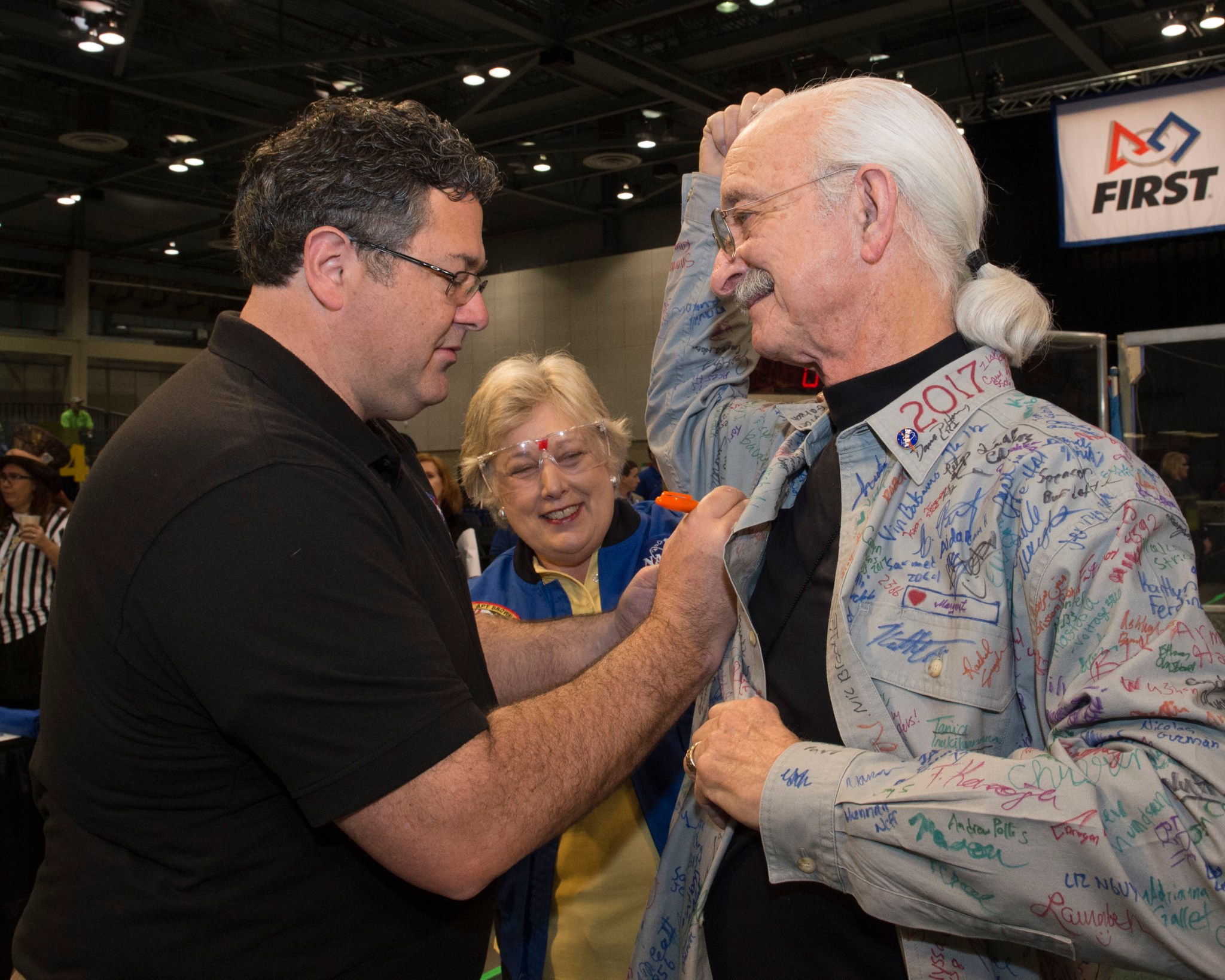
Marshall Director Todd May, left, adds his signature to the dozens on Woodie Flowers’ shirt as former astronaut Jan Davis, center, now vice president at Jacobs in Huntsville, looks on. All three were speakers at the opening ceremonies of the Rocket City Regional March 25. Flowers, a pioneer of hands-on engineering education, is a FIRST institution. He is Pappalardo Professor Emeritus of Mechanical Engineering at the Massachusetts Institute of Technology in Cambridge, serves as distinguished advisor to FIRST and participated in the design of the FIRST Robotics Competition for many years. (NASA/MSFC/Emmett Given)
Thomas Zurbuchen, NASA Associate Administrator for Science, Speaks at Marshall
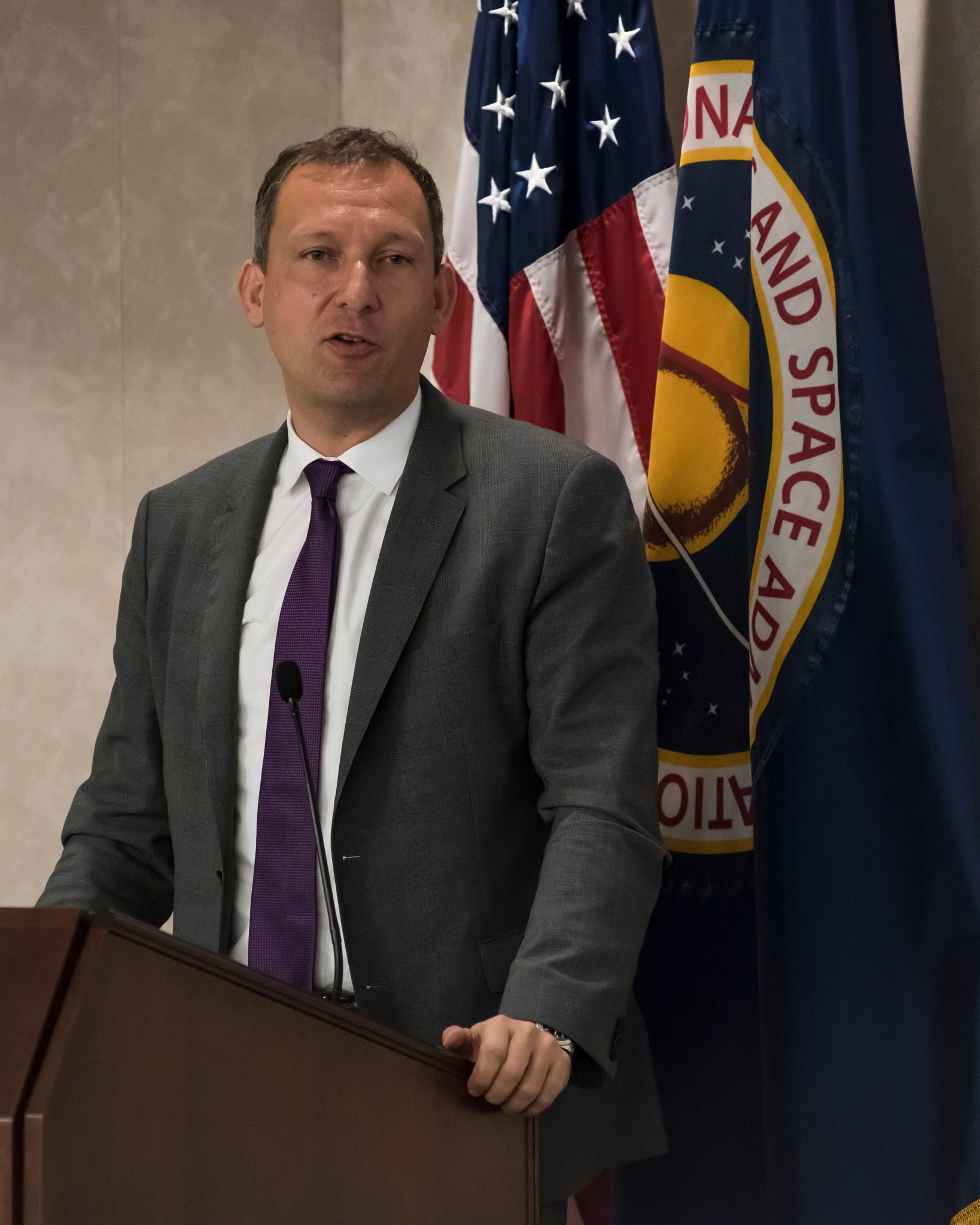
Thomas Zurbuchen, NASA associate administrator for the Science Mission Directorate at NASA Headquarters, addressed the March 21 Marshall Association luncheon at NASA’s Marshall Space Flight Center. A former professor of space science and aerospace engineering at the University of Michigan in Ann Arbor, Zurbuchen assumed his NASA role in October 2016. After speaking to the Marshall Association, he toured a number of Marshall laboratories and test facilities critical to ongoing NASA science and technology efforts, among them the laboratory where Marshall solar scientists, including Dr. Amy Winebarger, are preparing new sounding-rocket projects to study the behavior of Earth’s turbulent parent star. (NASA/MSFC/Fred Deaton)
This Week in NASA History: Saturn I SA-4 Test Flight Launches — March 28, 1963
This week in 1963, the Saturn I SA-4 test flight lifted off from NASA’s Kennedy Space Center. SA-4, an uncrewed test flight of the Saturn I booster, was the final of a series of four tests of the Saturn I first stage. Here, first stages for the SA-4, SA-6 and SA-7 missions are pictured at NASA Marshall Space Flight Center’s Fabrication and Assembly Engineering Division. Marshall designed, developed and managed the production of the Saturn I and the Saturn V rocket that took astronauts to the moon. Today, Marshall is developing NASA’s Space Launch System, the most powerful rocket ever built that will be capable of sending astronauts deeper into space than ever before, including to Mars. The NASA History Program is responsible for generating, disseminating, and preserving NASA’s remarkable history and providing a comprehensive understanding of the institutional, cultural, social, political, economic, technological, and scientific aspects of NASA’s activities in aeronautics and space. For more pictures like this one and to connect to NASA’s history, visit the Marshall History Program’s webpage. (NASA)
Obituary
Robert L. Green, 81, of Huntsville, died March 14. He retired from the Marshall Center in 2005 as an aerospace engineer. He is survived by his wife, Charlotte Green.



























